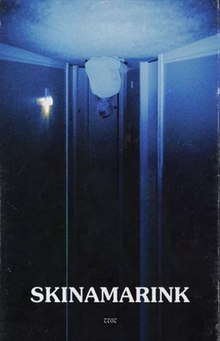A Review of ‘Skinamarink’ (2022)
[This review may contain spoilers]

‘Skinamarink’ (2022) Film Poster (photo courtesy of Wikipedia).
December 2, 2022
For long time horror fans, a common problem is that most horror movies just aren’t scary enough. When you know the formulas, the cliches, the patterns–traditional horror movies can lose their touch. For those non-horror-junkies, it can seem odd that someone would want to willingly watch something they know will send chills down their spine–but really, the love of horror isn’t all that different from a love of roller coasters or action movies. It’s the thrill, the adrenaline, the brief moments of pure terror followed by the comforting realization that you were perfectly safe all along–and for some seasoned horror fans, that specific joy can get harder and harder to find. For those in that particularly frustrating situation, look no further than “Skinamarink.”
Written and directed by Kyle Edward Ball, “Skinamarink” is a hundred minutes of pure terror–one reviewer called it the movie equivalent of that mad dash up the basement steps after all the lights have been turned off. It premiered at the 26th Fantasia Film Festival on July 25th, 2022 and despite its unconventional structure and risky stylistic choices, it received immediate praise from critics.
What little story it has centers around two young children, who awaken one night to find their parents (as well as the doors, windows, and various other objects in their house) have vanished–the rest of the film relies almost entirely on building a deeply tense atmosphere and delivering a wide selection of incredibly well executed jump scares.
Although the film was shot digitally, it’s edited to look grainy and scratchy, like old footage taken from cheap security cameras, or a VHS tape played one too many times. The messy visual quality and overall darkness of the environment adds tremendously to the unnerving air of the movie. Viewers never know what might be hiding behind dark corners or under the bed–they’re placed in the shoes of the children as the movie plays out with the same cadence of a nightmare that never seems to end, instilling them with a constant, overwhelming sense of dread.
Jamie McRae’s cinematography creates a feeling of isolation: never once do you see a proper face. There is no reassuring eye contact with a capable protagonist. The camera appears constantly abandoned–sat on the ground with its view half obscured by abandoned toys and slouching teddy bears, or on a table, gazing at some out of the way corner or stained patch of carpet. Everything is so shrouded in darkness that any glimpse of color is stifled by the shadows or washed out by the constant blue-white light of the TV and its endless marathon of eerie vintage cartoons and their droning soundtracks.
It’s an hour and forty minutes of near unbearable unease. Even the most unshakable horror fans will find themselves watching chunks of the movie through the gaps between their fingers, blankets pulled tightly around their shoulders. Though light on story and plot, “Skinamarink” meets the most basic (and oftentimes, shockingly hard to achieve) goal of the horror genre: to terrify. It’s a deconstruction of the genre to its most basic elements–a dark house, unfamiliar sounds, an isolated and innocent protagonist, a strange and ominous presence–and while it’s loose structure and abstract camerawork is certainly not for everyone, it’s a perfect 5/5 paws for the right audience.





















![Movie poster for '[Rec]" (2007).](https://www.lionnewspaper.com/wp-content/uploads/2023/04/rec-640x900.jpg)

